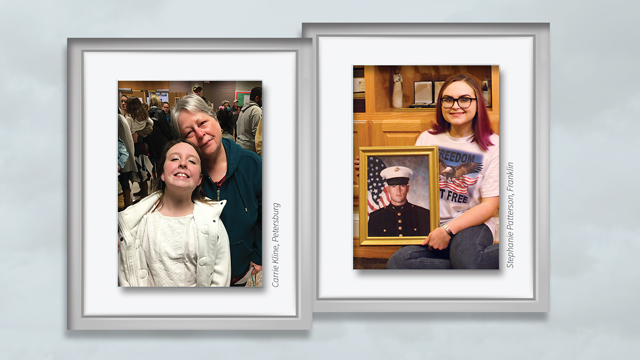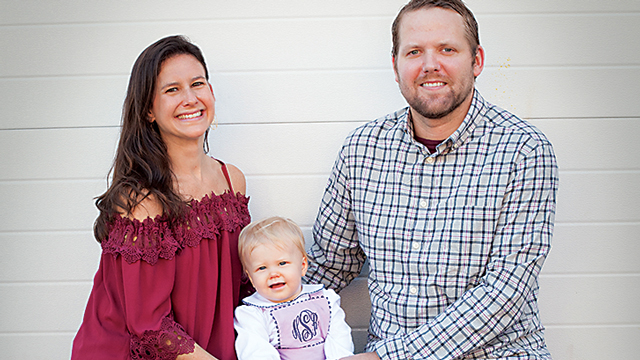A week after my grandmother passed away, a friend asked if my children were doing okay.
“I’m really not sure,” I told her. “I don’t even know how I’m doing.”
When we first learned of my grandmother’s sudden but peaceful death, my eight-year-old Evan cried his heart out. Then he threw some rocks into the woods and cried a little more.
My five-year-old was frustrated that she couldn’t cry. We found her sitting on her bed a few times, crinkling up her face and trying to squeeze out tears. She thought she needed to be sadder.
Then the questions began:
“What is Mammie doing tonight?”
“Can she eat all the candy she wants now?”
“Is she going to wear that outfit every day? Forever?”
“I want to see what heaven looks like, but I don’t want to go there to find out. Can we FaceTime?”
I didn’t have adequate answers to most of their questions, but I thought that if I at least acknowledged their concerns and validated their sadness, then I would be supporting them on some level.
But throughout the following weeks, I kept wondering if my children were handling their first experience with death appropriately. And for crying out loud: What does that even mean? What are the right and wrong ways for children to grieve?
Supporting Kids During the Mourning Process
First, I was uncertain about whether to allow my young children to attend my grandmother’s visitation and funeral. We discussed the situation as a family and decided they would not attend the more emotionally draining funeral service, but they would go to the visitation since family members would mostly be talking and reminiscing. The visitation would still give them an opportunity for closure.
“It’s important for children to process some sort of closure in the relationship with the person who died,” says Mark Loewen, licensed professional counselor with LaunchPad Counseling in Richmond. “How this looks depends on the family’s customs around death.”

In Loewen’s thirteen years of providing counseling, he has found that children are better able to handle funerals than most adults realize, and that preparation can make the process even smoother. He suggests explaining the format of the service to the child, along with the possible emotional responses from others in attendance. Tell the child that some people may cry, others may not, and most importantly – all reactions are just fine.
“Adults can explain to a child beforehand that the deceased person is no longer in their body and the funeral proceedings are a way for family and friends to say goodbye,” Loewen says.
It is important to support children before, during, and after the services and to make sure they are part of the family’s mourning process. This support includes acknowledging and, when possible, answering the child’s questions. This can be difficult and uncomfortable, as these questions are not easily answered.
“Why did Mammie die?” my children wanted to know. They needed an explanation – something to help them make sense of the loss.
“Mammie had gotten older,” we explained. “And she had a few health problems, also.”
“How old are you, Mom?” my son asked me. “Are you old? Will you die soon? When am I going to die?”
Even though nothing in life is certain, Loewen often tells parents that it is okay to reassure the child that his parents will not die for a long time, and that the child himself will live well into old age. “This is the most likely scenario, and it often calms the child’s anxiety,” he says. And if Mom or Dad (or some other adult) has a health condition that increases that person’s risk of death, Loewen suggests explaining all of the steps the adult is taking in order to become healthier.
Responding Helpfully to a Child
It is critical to respond to a child’s questions, even though the conversations can be very difficult. Answered questions provide a sense of security, and when there are no more answers, parents can simply support the child’s current emotion.
When attempting to provide support, parents must be careful to not further confuse their children. While well intended, some messages can leave a child feeling more concerned and vulnerable. Telling a young child that his deceased family member is in a better place, for example, can be puzzling.
How can that be? the child might wonder. How can any place be better than right here with the rest of the family and me?
“It was just her time to go,” an adult might offer.
Her time? What does that mean? When is it my time? a child might think.
Well-intentioned rationalizations, especially those that are spiritual in nature, can be very confusing to a young child, as well. Death, after all, is difficult for adults to manage. So, telling a child that “God needed an angel” is not a good idea. A child might process this by thinking God will swoop in at any time and choose another one. Additionally, it is not advisable to refer to the deceased family member as either “asleep” or “resting.” This can be disruptive to the child’s own sleep routine and add to feelings of uncertainty and instability, the very opposite result of what is desired.
Loewen says it’s much more helpful to “identify what the child’s feelings are and say those feelings back to him.” Better avenues to take include acknowledging the child’s sadness or anger and sharing our own feelings. We might say, “I can see you are upset that Grandma isn’t here to celebrate with us.” Or, “I also wish Grandpa were here so we could show him the picture you drew.”
“An expression of feelings normalizes the emotion and allows it to exist without having to fight it,” Loewen says. “Then, the parent can guide the child to something that will help him feel better.”
Which Feelings Are Acceptable?
Like that of adults, a child’s grief can manifest in different ways. Some children express their grief through tears, and some tend to feel angry. Loewen recommends that regardless of the emotion or feeling the child is experiencing, it’s important to stay with it and not try to make it go away. A child who is especially sad may need to spend some time close to his parents, and an angry child might need to run around outside somewhere or throw a ball.
Grief can be unpredictable and ugly, and it can often show up as misbehavior in children. Parents should remember (and remind the grieving child) that while all feelings are acceptable, not all behaviors are. Repeated acting out and overwhelming disruptions to the family’s schedule could indicate the need for professional help.
In our efforts to provide comfort, we often put our own feelings of sadness away for fear of further upsetting our children. Parents need their own outlets for grief – apart from their children – such as support meetings or friend groups. That does not mean, however, that it is wrong to cry in front of children; it’s not. Feelings of loss and sadness surface unexpectedly after a death, and it is fine for children to see that these feelings come and go and are a natural part of life.
Read with Your Children to Explore Grief
Books can be a helpful resource when we feel our own words aren’t adequate. My son, Evan, and I took a trip to our local library to see what was available for young readers on the topic of grief. Together we read about eight children’s books, some with religious themes and others that were purely self-help.
Sad Isn’t Bad: A Good-grief Guidebook for Kids Dealing with Loss by Michaelene Mundy, is a self-help book for children that reassures them that it is okay to cry. The guidebook addresses feelings of guilt and blame, as well as physical symptoms, like headaches and stomachaches, which are common manifestations of grief in children.
The most relatable book we found, Death Is Stupid by Anastasia Higginbotham, is written in the language of a child and told partially from a child’s point of view. The book opens with some of the awkward-sounding things that people say to children after a death such as, “I know how you feel” and “She’s in a better place.”
“We lost her,” a relative says to the main character, in reference to his deceased grandmother.
“Then find her,” the child responds.
In a child’s mind, when something is lost, we should be able to find it, right? This book illustrates the importance of being careful with the words we choose and the messages we send to children and how those messages might be interpreted.
The book also addresses that beliefs about the afterlife are personal and individual, and it reminds children that even though everyone at some point experiences loss, people’s pain is never the same.
The end of the book focuses heavily on remembering and keeping connections with deceased individuals. Suggestions include: wearing an item of their clothing, playing games they liked, and making favorite foods they made.
The author also suggests that children talk aloud to their deceased family member and imagine how that individual might respond.
“Gramma, you shouldn’t have died. I still need you,” says the child in the story.
“Oh, honey, I know,” Gramma responds. “Death is so stupid.”
Maintaining Balance in Life and Death
Loewen reminds parents of a lesson that was fleshed out in the popular Pixar movie Inside Out: You can’t experience sadness without happiness. “Healthy expressions of grief allow us to remember what we had,” says Loewen. “In times of grief, it is normal for families to argue more and use unhealthy coping skills at times. But balance is key. And giving each other grace and compassion is most important.”
We have to be patient with our children and ourselves and recognize that we are doing our best with a life-altering experience for which there is no fail-safe guide. If we are showing our kids love, supporting their emotions, and providing them opportunities to talk, cry, and remember, then we are doing well.
Just the other night, my husband, children, and I were on our way home from visiting my parents when Evan called out to me from the backseat.
“Mom?” his voice cracked.
“Yes, Evan?”
“I miss Mammie,” he said.
“I do, too,” I told him. “Do you want to talk about her?”
He didn’t want to talk this time. He just wanted me to reach back and grab his hand. So I did, and I held it for the rest of our drive home.
How Families Give Voice to Grief
While each loss is unique, there is a certain comfort found in sharing individual experiences with others. It can help to know that even though our paths may begin at different places, we are all in search of the same destination of honoring the lives of our loved ones. It was my privilege to speak with the following individuals and share their stories of grieving, coping, and remembering. It is my hope that their messages will reach the readers who need them the most.

Jessica Carwile Bain’s father-in-law, mother-in-law, and the family’s dog, a German shepherd named Chief, all passed away within a year. It took quite a toll on their young son, Edwin. As a result, Edwin acted out at times, a very common reaction to loss.
“We let him talk out his emotions and told him it’s okay to be upset and angry,” says Jessica. “We told him we would always be here for him and we love him, but he can’t be mean to others because his heart hurts.”
Little Edwin eventually found comfort in thinking of his loved ones together in heaven and when it thunders, it means they are all bowling. Each time it storms, Jessica says the family talks about who is most likely winning that particular frame.
_________________________________________________________
Christine Smith’s husband, Patrick “Smitty” Smith, passed away in September 2019, after battling brain cancer. Their daughter, Norah, was about to turn three years old.
While Christine credits the team at VCU Health for helping her manage the logistics of the early days of loss, it was a children’s book that served as a primary source of comfort in the beginning. The Invisible String by Patrice Karst was presented to the Smith family while Patrick was still alive, and the three of them had the opportunity to read it together.
“I can’t say enough good things about this book,” says Christine. “While it doesn’t speak of death too specifically, the theme is that no matter whether folks are here physically, we are all connected by one long, loving string. So any time you miss someone, you pull your string and that person feels it tugging their heart from wherever they are. It resonated so well for Norah, and I am so, so grateful for this coping mechanism. Any time my eyes water, Norah immediately tells me to pull my string.”
Christine included her young daughter in many aspects of Patrick’s service and the celebration of his life with friends and family. At the church, Norah played in the aisle during the priest’s homily and accompanied family members to the altar for a special reading. Family members and friends commented that her presence at the service was a reminder that life would continue and that they would be okay.
The positive energy continued at the celebration of life (what others might call a wake) after the church service. “I asked that folks share messages of their favorite giggles with Patrick, both to warm my heart while feeling such pain, and to ensure we would have many fun stories that will forever bring a smile to Norah’s face, as I remind her of who her Daddy was and how many lives he touched in the very best way while he was here,” says Christine.
Each evening since his passing, Christine and Norah take some time to talk to Patrick at bedtime. They discuss Norah’s favorite events of the day in an effort to ensure that Patrick remains a major part of their daughter’s life.

When Carrie Kline’s mother passed away, her 11-year-old daughter, Lexi, initially did not shed a tear. “We were talking about her reaction,” Carrie says, “And Lexi said that Grammy told her not to be sad, that she was going to a better place and would not be in pain.” As Carrie explained, her daughter said she was doing exactly what her grandmother told her to do – not be sad! “She said she couldn’t understand what was wrong with the rest of us – carrying on and crying like we were,” Carrie says.
Carrie’s family hosted a cookout in order to say goodbye to her mother and provide some closure since there wasn’t a formal memorial service. They worked to keep her mother’s memory alive in their holiday traditions this year.
“Lexi and Grammy always loved eating canned, jellied cranberries at Thanksgiving. They were the only ones who liked them,” says Carrie. “So we will definitely keep that going, too, even if we end up throwing most of it away.”
_______________________________________________________
In 2005, Stephanie Patterson’s husband, Jayton, a United States Marine, was killed in Iraq by a roadside explosive. Their daughter, Claire, was fifteen months old at the time, so Stephanie was busy with the immediate and constant job of taking care of a young toddler.
“Claire was too young to comprehend why I wasn’t lively or affectionate, but also too young to expect it. I did try to hide my displays of sad emotions from her, and at the time I didn’t feel many happy ones,” says Stephanie. “If I showed sadness through crying, Claire would offer support and rub my head as though I had stubbed my toe.”
Today, Stephanie helps her 16-year-old daughter connect to her father and keep his memory alive by wearing special t-shirts and bracelets and running a race in his memory.
“In May of 2019, Claire decorated a shirt with a picture of Jayton holding her as a baby. I waited anxiously by the finish line for her and when she burst through, I was really proud,” says Stephanie. Later, Stephanie asked Claire how the race went, and she said she started to struggle during the last few miles. That’s when a woman running at a similar pace saw Claire’s shirt and asked about her father. “She encouraged Claire to keep going and told her that her dad was there and really proud of her,” says Stephanie. Claire told her mom that this lady’s kind and encouraging words helped motivate her that last mile and helped her cross that finish line.





